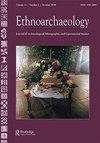凤尾鱼(Coccinia abyssinica):一种被视为埃塞俄比亚西南部瓦拉加地区妇女亲戚的块茎植物
IF 1.3
0 ARCHAEOLOGY
引用次数: 5
摘要
本文讨论了凤尾鱼的种植、收获和消费,并考察了影响这种做法的社会和环境因素。鳀鱼,一种由种子繁殖的本地块茎作物,主要因其可食用块茎而种植。除了构成瓦拉加奥罗莫人主食的一部分外,块茎也是人们文化和身份的核心。块茎是拟人化的,通常被认为是有生育能力的妇女的亲戚。事实上,块茎、妇女和陶器形成了奥罗莫宇宙学中不可或缺的隐喻意义的联系。此外,块茎的种植是由农民之间的日常互动构成的。理解瓦拉加奥罗莫人如何在瞬息万变的世界中努力保留、修改或改变鳀鱼文化的关键是对农田的感知代理。凤尾鱼在陶罐中蒸熟,加工后形成诊断用变。这种用法的改变可能有助于想象埃塞俄比亚西南部高原瓦拉加地区块茎生产和消费的古代。本文章由计算机程序翻译,如有差异,请以英文原文为准。
Anchote (Coccinia abyssinica): A Tuber Viewed as a Relative of Women in the Wallaga Region of Southwestern Ethiopia
ABSTRACT This paper discusses the cultivation, harvesting and consumption of anchote and examines the social and environmental factors that frame the practice. Anchote, an indigenous tuber crop propagated by seed, is primarily cultivated for its edible tubers. In addition to forming part of the dietary staple of the Wallaga Oromo, the tuber is central to the culture and identity of the people. The tuber is anthropomorphized and often referred to as a relative of fertile women. Indeed, the tuber, women and pottery form a nexus of metaphorical meaning integral to Oromo cosmology. Moreover, cultivation of the tuber is framed by the daily interaction between farmers. The perceived agency of farmland is key to understanding how the Wallaga Oromo struggle to retain, modify or alter anchote culture in a swiftly changing world. Anchote is steamed in a clay pot and its processing results in formation of diagnostic use-alteration. This use-alteration may help to envisage antiquity of tuber production and consumption in the Wallaga region of the southwestern Ethiopian highlands.
求助全文
通过发布文献求助,成功后即可免费获取论文全文。
去求助
来源期刊

Ethnoarchaeology
ARCHAEOLOGY-
CiteScore
1.60
自引率
0.00%
发文量
10
期刊介绍:
Ethnoarchaeology, a cross-cultural peer-reviewed journal, focuses on the present position, impact of, and future prospects of ethnoarchaeological and experimental studies approaches to anthropological research. The primary goal of this journal is to provide practitioners with an intellectual platform to showcase and appraise current research and theoretical and methodological directions for the 21st century. Although there has been an exponential increase in ethnoarchaeological and experimental research in the past thirty years, there is little that unifies or defines our subdiscipline. Ethnoarchaeology addresses this need, exploring what distinguishes ethnoarchaeological and experimental approaches, what methods connect practitioners, and what unique suite of research attributes we contribute to the better understanding of the human condition. In addition to research articles, the journal publishes book and other media reviews, periodic theme issues, and position statements by noted scholars.
 求助内容:
求助内容: 应助结果提醒方式:
应助结果提醒方式:


